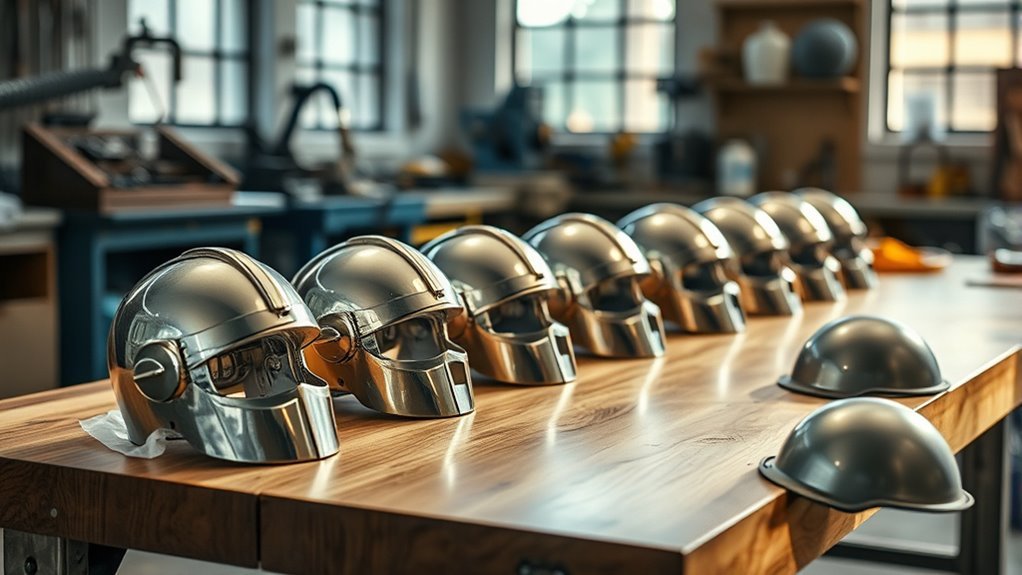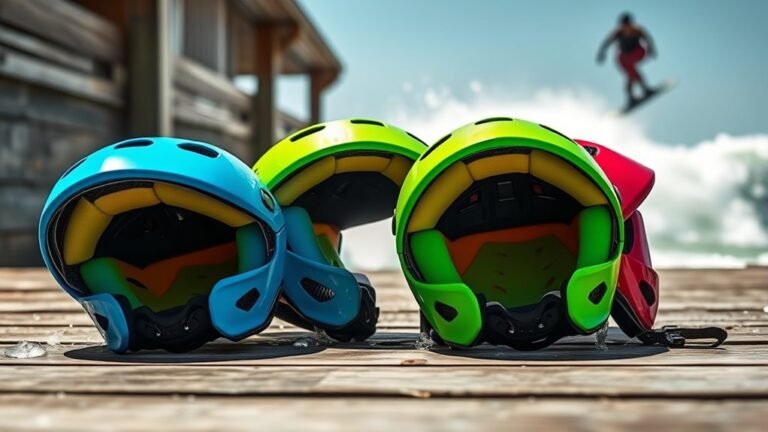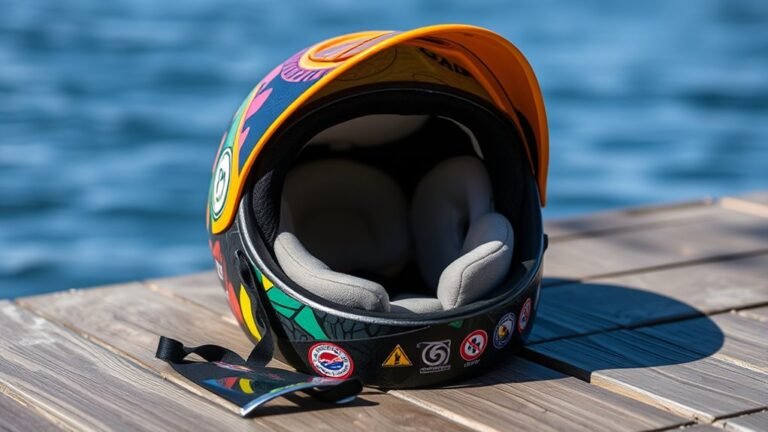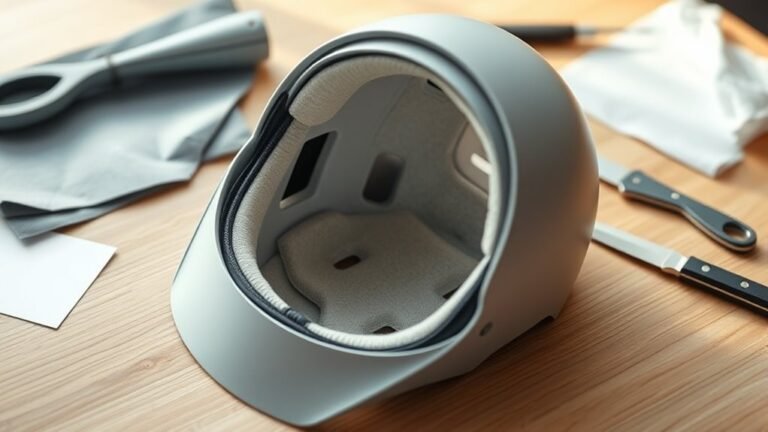Using Molds for Repeating Helmet Parts
Using molds for repeating helmet parts is essential for achieving consistency and precision in production. Different mold types, like silicone and thermoplastic, enhance performance and safety. They minimize waste while maintaining high quality, allowing for rapid scaling and adaptation to market demands. The process includes careful material selection and rigorous testing to guarantee reliability. By optimizing production techniques, you can effectively enhance both the design and efficiency of helmet components. Further insights await your exploration.
Understanding the Different Types of Molds Used in Helmet Production

When considering helmet production, it is essential to understand the various types of molds employed, as each plays a critical role in determining the helmet’s performance and safety features. Silicone molds are often used for their flexibility and ability to capture intricate designs, allowing for customized helmet shapes that enhance comfort and fit. On the other hand, thermoplastic molds are favored for their durability and ability to withstand high temperatures during production. These molds enable the efficient mass production of helmet components, ensuring consistency in quality. Understanding these mold types empowers manufacturers to optimize helmet design, maximizing both safety and user experience while preserving the freedom of movement essential for helmet wearers.
The Advantages of Using Molds for Helmet Parts
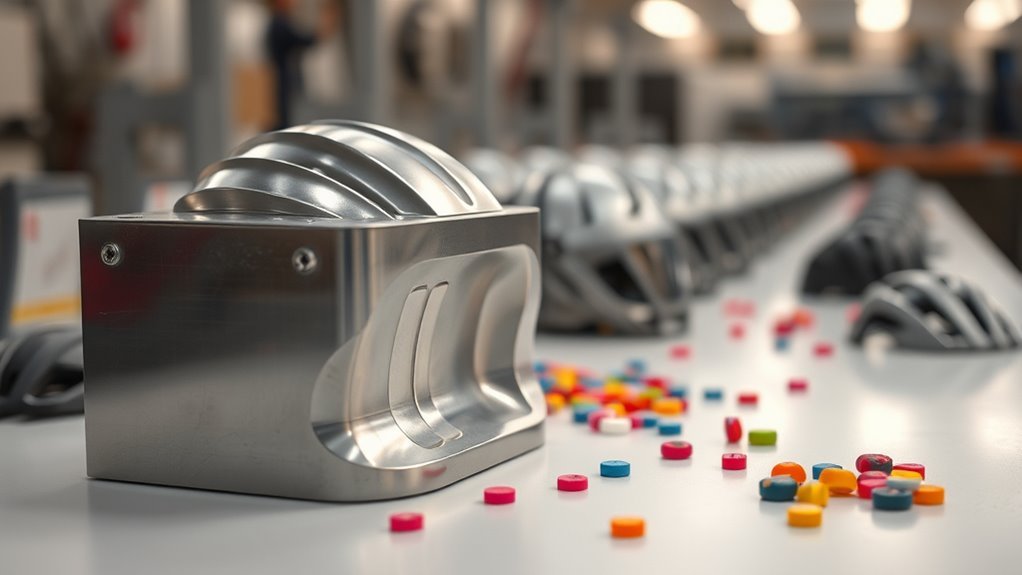
Molds offer numerous advantages in the production of helmet parts, enhancing both efficiency and quality. One key benefit is mold durability, which allows for high-volume production without compromising consistency. Durable molds can withstand repeated use, considerably reducing the need for frequent replacements and maintenance. This longevity contributes to better production efficiency as it streamlines manufacturing processes. Additionally, by utilizing molds, you can achieve precise dimensions and uniformity in each helmet part, ensuring that safety standards are met without variation. This level of precision not only saves time in quality control but also minimizes waste. Ultimately, molds facilitate a balance of performance and reliability, empowering you to create superior helmet components while maintaining operational freedom in your manufacturing workflow.
The Process of Creating Molds for Helmet Components
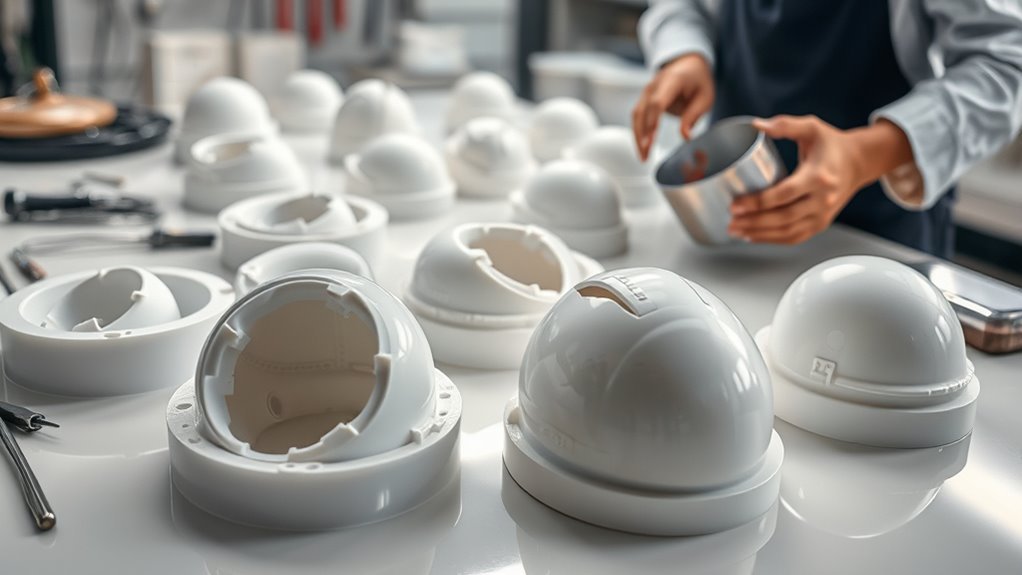
Creating molds for helmet components involves several critical steps that confirm both functionality and safety. First, you’ll need to employ effective mold preparation techniques. This includes selecting appropriate materials and creating a detailed prototype to guarantee accurate dimensions. Once your prototype is ready, you can proceed to the mold-making stage, where you’ll pour the selected material into the mold cavity. After allowing it to set, you’ll initiate the mold curing processes, which are essential for achieving the desired strength and durability. Proper curing not only enhances the mold’s performance but also extends its lifespan. By following these steps meticulously, you can produce high-quality helmet components that meet safety standards while allowing for creative freedom in design.
Ensuring Quality Control in Mold Production
In ensuring quality control during mold production, selecting the appropriate mold material is essential to achieving ideal performance and durability. You’ll need to implement rigorous inspection and testing procedures to verify that each component meets the required standards. These steps are important for maintaining consistency and reliability in the final helmet parts.
Mold Material Selection
Selecting the right mold material is vital for guaranteeing quality control in helmet part production. Your choices, such as silicone and polyurethane, will greatly impact the final product’s durability and performance. When considering mold material, keep the following in mind:
- Durability: Confirm the material withstands repeated use without degradation.
- Flexibility: Silicone selection offers excellent flexibility for intricate designs.
- Heat Resistance: Polyurethane options can handle high temperatures, essential for various manufacturing processes.
- Ease of Release: A smooth finish aids in demolding and reduces defects.
- Cost-Effectiveness: Balance quality with budget constraints to maintain profitability.
Inspection and Testing Procedures
Once the appropriate mold materials are chosen, the next step involves implementing rigorous inspection and testing procedures to secure quality control in mold production. You’ll want to begin with visual inspection, evaluating the mold for any visible defects such as cracks or surface imperfections. This is essential because even minor flaws can affect the final product’s integrity. Following that, you’ll need to adhere to established testing standards, which might include dimensional checks and material property evaluations. These tests guarantee that the mold meets specified tolerances and performance criteria. By systematically applying these procedures, you can confidently verify that each mold part produced is reliable and meets your quality expectations, ultimately leading to safer and more effective helmet components.
Innovations in Mold Design for Enhanced Efficiency
As advancements in materials and technology continue to reshape the manufacturing landscape, innovations in mold design are proving essential for enhancing efficiency in helmet part production. You’ll find that employing techniques like 3D printing and modular design greatly streamlines the process. These innovations allow for rapid prototyping and flexibility in design modifications, reducing lead times and waste.
- Enhanced cooling systems for faster cycle times
- Integration of smart sensors for real-time monitoring
- Use of lightweight, durable materials to reduce costs
- Modular components for quick assembly and maintenance
- Advanced surface finishes to improve part quality
Scaling Production With Molds: Meeting Market Demands
When scaling production with molds, you’re revealing significant benefits that directly address market demands. By streamlining your production processes, you enhance efficiency while ensuring consistency and quality in each helmet part. This approach not only meets current needs but also positions you favorably for future growth.
Benefits of Mold Usage
While many manufacturers face challenges in scaling production, utilizing molds for helmet parts offers a streamlined solution that effectively meets market demands. The benefits of mold usage are notable, particularly in enhancing operational efficiency and product consistency.
- Mold Longevity: Durable molds can withstand high production volumes, reducing replacement frequency.
- Cost Efficiency: Lower material waste and minimized labor costs lead to significant savings.
- Rapid Prototyping: Quick mold creation allows for faster iterations and product testing.
- Design Flexibility: Molds can accommodate complex shapes, meeting diverse design requirements.
- Scalability: Easily adjust production levels to align with market fluctuations.
Streamlining Production Processes
To effectively meet market demands, streamlining production processes through the use of molds is essential for helmet manufacturers. By implementing molds, you can greatly enhance production efficiency, allowing for rapid turnaround times and the ability to scale output according to fluctuating market needs. Molds enable a high degree of precision, reducing material waste and minimizing errors during the manufacturing process. This leads to substantial cost reduction, as you can produce parts in bulk without sacrificing quality. Additionally, molds facilitate easier integration of new designs, enabling you to adapt swiftly to consumer preferences. Ultimately, leveraging molds not only optimizes your production line but also empowers your business to remain competitive in a dynamic market landscape.
Enhancing Consistency and Quality
By employing molds in production, helmet manufacturers can greatly enhance consistency and quality across their product lines. This approach not only streamlines manufacturing but also guarantees that each product meets rigorous design considerations. Here are some key benefits of using molds:
- Precision: Molds enable highly accurate replication of helmet parts.
- Reduced Variability: Consistent production techniques minimize discrepancies.
- Material Efficiency: Optimized designs lead to less waste.
- Faster Turnaround: Molds allow rapid scaling to meet market demands.
- Cost-Effectiveness: Initial investment in molds pays off through mass production savings.
Case Studies: Successful Implementation of Molds in Helmet Manufacturing
Molds have revolutionized helmet manufacturing, providing a reliable method for producing high-quality components with precision and efficiency. Case studies highlight various successful mold applications that enhance both the production process and the final product. For instance, a leading manufacturer adopted injection molding for visor components, achieving uniform thickness and improved impact resistance. Another case involved the use of silicone molds for padding inserts, which allowed for rapid prototyping and customization, catering to diverse athlete needs. These examples illustrate how implementing molds not only streamlines operations but also elevates safety standards. By leveraging these advanced techniques, you can guarantee consistency and quality in your helmet production, ultimately offering users a superior product while maintaining the freedom of design innovation.
Frequently Asked Questions
How Long Does It Take to Create a Mold for Helmet Parts?
“Good things come to those who wait.” The mold creation timeline for helmet parts typically ranges from a few days to several weeks. This duration hinges on the mold design complexity; intricate designs necessitate more time for both planning and execution. If you want a high-quality mold, it’s essential to factor in these variables. Ultimately, investing time now will yield better results, ensuring your helmet parts meet the desired specifications and performance standards.
What Materials Are Commonly Used for Helmet Molds?
Common materials for helmet molds include silicone and epoxy resin. Silicone molds are favored for their flexibility and durability, allowing for easy demolding and repeated use. They’re ideal for intricate designs, ensuring detail retention. On the other hand, epoxy resin is used for its strength and rigidity, providing a solid structure. Both materials serve distinct purposes, depending on whether you prioritize detail or durability in your helmet production process.
Can Molds Be Reused for Different Helmet Designs?
Yes, molds can be reused for different helmet designs, showcasing mold versatility and design adaptability. By making slight modifications to the original mold, you can achieve new shapes and features while maintaining structural integrity. This approach not only saves time and resources but also allows you to explore creative possibilities without starting from scratch. However, it’s essential to guarantee that the changes align with safety standards and performance requirements.
How Do Molds Impact the Overall Weight of Helmets?
Molds greatly impact a helmet’s overall weight through weight distribution and material selection. When you choose lighter materials and design molds that enhance balance, you can create helmets that feel less cumbersome. Properly designed molds guarantee uniform thickness, allowing for ideal weight distribution, which improves comfort and performance. By focusing on these elements, you can achieve a helmet that’s not only protective but also lightweight, giving you the freedom to move without feeling restricted.
What Maintenance Is Required for Mold Longevity?
To guarantee mold longevity, you need regular mold cleaning and proper mold storage. Clean molds after each use to remove any debris or residue, preventing contamination. Use a gentle detergent and avoid harsh chemicals that can damage the surface. Store molds in a climate-controlled environment to prevent warping or moisture buildup. Regular inspections for wear and tear are essential, too, as maintaining their integrity will ultimately enhance your production efficiency and quality.
